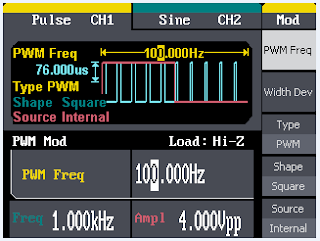 |
| Figure 1: Teledyne LeCroy's WaveStation waveform generator |
The best place to start in generating a PWM signal is with a square wave. Most PWM signals start with one anyway. Many waveform generators, including Teledyne LeCroy's WaveStation family (Figure 1), will default to a 50% duty cycle. That is the equivalent of a steady-state control signal at half-power. Most waveform generators will permit varying the duty cycle from 20% to 80%, giving you latitude to do some troubleshooting. As described in an earlier post, you could use burst mode to obtain lower duty cycles if needed.
 |
| Figure 2: Built-in PWM capabilities simplify the task of creating PWM waveforms |
If you've got a waveform generator that has built-in PWM capabilities, then this exercise is a no-brainer (Figure 2). The WaveStation generators fit this description, providing easy access to a number of parameters including PWM frequency, width deviation, and shape. Either internal or external waveforms can serve as the modulation source.
With their built-in PWM capabilities, the WaveStation generators can emulate digital control devices for system evaluation. This serves applications such as the forementioned lighting and motor control as well as engine control and anywhere else you need digital logic to emulate an analog feel.
No comments:
Post a Comment